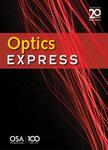版权所有:内蒙古大学图书馆 技术提供:维普资讯• 智图
内蒙古自治区呼和浩特市赛罕区大学西街235号 邮编: 010021

作者机构:Yale Univ Dept Elect Engn New Haven CT 06511 USA
出 版 物:《OPTICS EXPRESS》 (Opt. Express)
年 卷 期:2010年第18卷第12期
页 面:12615-12621页
核心收录:
学科分类:070207[理学-光学] 07[理学] 08[工学] 0803[工学-光学工程] 0702[理学-物理学]
基 金:DARPA/MTO [N66001-09-1-2071] Alexander-von-Humboldt foundation Packard Fellowship in Science and Engineering National Science Foundation Division Of Computer and Network Systems Direct For Computer & Info Scie & Enginr Funding Source: National Science Foundation
主 题:Computation methods Dielectric waveguides Numerical simulation Optical force Tunable filters Waveguide modes
摘 要:We employ the finite-difference time-domain method to calculate the dominant short range forces in optomechanical devices, Casimir and gradient optical forces. Numerical results are obtained for typical silicon optomechanical devices and are compared to metallic reference structures, taking into account geometric and frequency dispersion of silicon. Our results indicate that although a small gap is desirable for operating optomechanical devices, the Casimir force offsets the gradient force in strongly coupled optomechanical devices, which has to be taken into account in the design of optical force tunable devices. (C) 2010 Optical Society of America